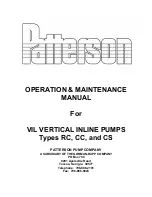
GB
3.5 Maintenance Model 1/2", Bolted Version
3.5.1 Maintenance of Check Valve and O-Ring
. Flush and neutralize the pump to be certain all corrosives or hazardous materials are removed prior to any main-
tenance. This procedure should always be followed when returning pumps for factory service also.
. Remove nuts (8) from bolts (6) in both the discharge and suctions manifolds. Suction check valve seats and
check balls (6, 7) are located inside of the bottom of the outer chamber (8). Gently remove and inspect for
excessive wear, pitting or other signs of degradation. Inspect valve seat and manifold o-rings (9,38). Replace
if necessary. Discharge check valves are located inside of the bottom of the discharge elbows (3).
3. When re-assembling, the check ball should fit within the ball cavity of the chamber and discharge manifold.
Press fit the valve seats into position with the curved portion facing the ball. Lightly tighten fasteners. Tighten
all external fasteners to final torque requirement after pump is completely assembled.
Caution!
When using pumps built with PTFE o-rings always replace with new PTFE o-rings, since the original o-rings
may not reseal the pump.
3.5.2 Maintenance of Diaphragm and Pilot Sleeve Assembly
4. To inspect diaphragms remove nuts (8) from bolts (6) from the outer pumping chambers (8). If replacement
is necessary due to abrasion or rupture unscrew the outer diaphragm plates (9). Models that are built with PTFE
elastomers will have a PTFE overlay (30) that faces the outer pumping chamber (8) and a back-up diaphragm
(3) on the air side of pump. Pumps without PTFE will contain only the back-up diaphragms (3).
5. If a diaphragm has been ruptured and corrosive or viscous fluid has entered the air side of the pump, the com-
plete air system should be inspected. After removing diaphragms and inner diaphragm plate (33), the pilot sleeve
assembly (4, 40, 4, 45-47) and diaphragm rod assembly (3, 5) may be removed by removing the retaining
plates (4) and push the entire unit out through the bore in the intermediate (34). Diaphragm rod assembly must
be unscrewed to remove pilot sleeve.
Caution!
To aid in reassembly use a non-synthetic, petroleum based lubricating grease without EP additives.
6. Clean or replace any components that have excessive wear, dirt build-up, or chemical attack. Lube all compo-
nents prior to reassembling. Reassemble pilot sleeve spacers (47), o-rings (4) and lip seals (40) within bore of
intermediate. Make sure that the open side of the lip seals (40) is facing outward toward the diaphragms. Also
make sure that the end pilot spacers (4) are at the end on either side of the pilot sleeve assembly and all inner
spacers (47) are separated by o-rings (46). Next carefully insert the diaphragm rod assembly (3.5) with pilot
sleeve (45) inside the assembly in the bore. Reattach retaining plates (4). Do not over tighten self-tapping
screws (4).
Maintenance Model 1/2", Bolted Version
Содержание Size 1 - 1/4"
Страница 39: ...39 GB Dimensions in mm 5 2 Model 3 8 Outlet Air Inlet Inlet 4 Slots Dia 7 6 Front View Side View...
Страница 49: ...49 GB 6 Performance Curves 6 1 Model 1 4 6 2 Model 3 8 Band Clamp Version...
Страница 50: ...50 GB 6 4 Model 1 2 Bolted Version 6 3 Model 1 2 Band Clamp Version...
Страница 51: ...51 GB 6 6 Model 1 Bolted Version 6 5 Model 1 Band Clamp Version...
Страница 52: ...52 GB 6 8 Model 1 1 2 Bolted Version 6 7 Model 1 1 2 Band Clamp Version...
Страница 53: ...53 GB 6 10 Model 2 Bolted Version 6 9 Model 2 Band Clamp Version...
Страница 54: ...54 GB 6 11 Model 3 Bolted Version...
Страница 56: ...56 GB...
Страница 58: ...58 GB...
Страница 59: ...59 GB...
















































